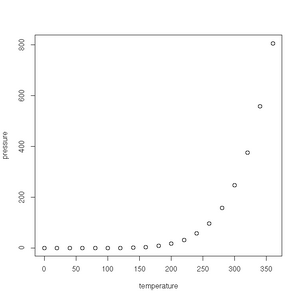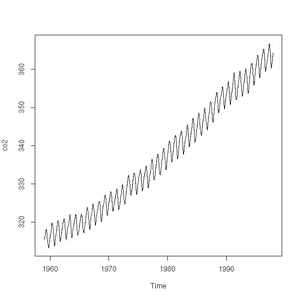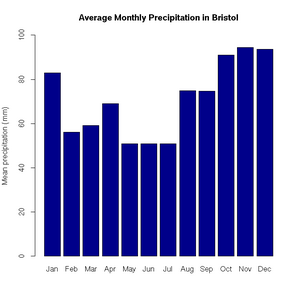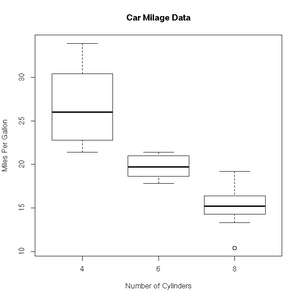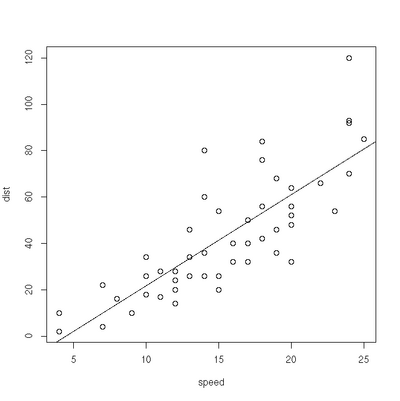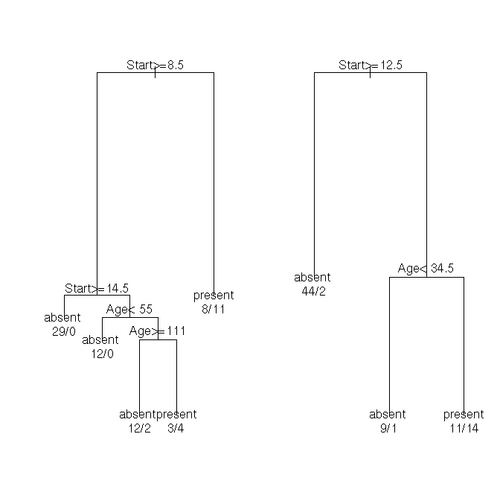Difference between revisions of "R1"
| Line 428: | Line 428: | ||
===Sorting=== | ===Sorting=== | ||
| − | + | Using '''sort''': | |
<source> | <source> | ||
| Line 440: | Line 440: | ||
===Random Sampling=== | ===Random Sampling=== | ||
| − | + | Using '''sample''': | |
<source> | <source> | ||
| Line 459: | Line 459: | ||
See: http://stat.ethz.ch/R-manual/R-devel/library/base/html/sample.html | See: http://stat.ethz.ch/R-manual/R-devel/library/base/html/sample.html | ||
| + | |||
| + | ===Combining=== | ||
| + | |||
| + | Using '''rbind''' to add combine the rows to two data frames: | ||
| + | |||
| + | <source> | ||
| + | > country <- c("France", "Italy", "Hungary", "Australia") | ||
| + | > gold <- c(11, 8, 8, 7) | ||
| + | > silver <- c(11, 9, 4, 16) | ||
| + | > bronze <- c(12, 11, 5, 12) | ||
| + | > extras.2012 <- data.frame(country, gold, silver, bronze) | ||
| + | > rbind(medals.2012, extras.2012) | ||
| + | country gold silver bronze | ||
| + | 1 USA 46 29 29 | ||
| + | 2 China 38 27 23 | ||
| + | 3 Great Britain 29 17 19 | ||
| + | 4 Russian Federation 24 26 32 | ||
| + | 5 Republic of Korea 13 8 7 | ||
| + | 6 Germany 11 19 14 | ||
| + | 7 France 11 11 12 | ||
| + | 8 Italy 8 9 11 | ||
| + | 9 Hungary 8 4 5 | ||
| + | 10 Australia 7 16 12 | ||
| + | </source> | ||
| + | |||
| + | See: http://stat.ethz.ch/R-manual/R-devel/library/base/html/cbind.html | ||
==Linear Regression== | ==Linear Regression== | ||
Revision as of 16:36, 28 November 2013
Open Source Statistics with R
Introduction
R is a mature, open-source (i.e. free!) statistics package, with an intuitive interface, excellent graphics and a vibrant community constantly adding new methods for the statistical investigation of your data to the library of packages available.
The goal of this tutorial is to introduce you to the R package, and not to be an introductory course in statistics.
If you are working on a Linux system, you will typically start R from the command line. On a Windows machine, or a Mac, you will typically start up R in some form of GUI. However you get R started, you will have access to an R command prompt. The good news is that the examples below will all work at the R command prompt, however you gained access to it.
Further resources:
- The R manual is a great resource for learning R: http://cran.r-project.org/doc/manuals/r-release/R-intro.pdf
- Some excellent examples of using R can also be found at: http://msenux.redwoods.edu/math/R/ and http://www.r-tutor.com/
Getting Started
The very simplest thing we can do with R is to perform some arithmetic at the command prompt:
> phi <- (1+sqrt(5))/2
> phi
[1] 1.618034Parentheses are used to modify the usual order of precedence of the operators (/ will typically be evaluated before +). Note the [1] accompanying the returned value. All numbers entered at the console are interpreted as a vector. The '[1]' indicates that the line in question is displaying the vector of values starting at first index. We can use the handy sequence function to create a vector containing more than a single element:
> odds <- seq(from=1, to=67, by=2)
> odds
[1] 1 3 5 7 9 11 13 15 17 19 21 23 25 27 29 31 33 35 37 39 41 43 45 47 49
[26] 51 53 55 57 59 61 63 65 67From the above example, we can see that both the <- and = operators can be used for assignment.
Vectors are commonly used data structures in R:
coords.bris <- c(51.5, 2.6)As are matrices:
> magic <- matrix(data=c(2,7,6,9,5,1,4,3,8),nrow=3,ncol=3)
> magic
[,1] [,2] [,3]
[1,] 2 9 4
[2,] 7 5 3
[3,] 6 1 8Where the c function combines the arguments given in the parentheses. We can access portions of the array using the syntax shown in the square brackets. For example, we can access the first row using the [1,] notation, and similarly the second column using [,2]. Since the square is 3x3 magic, the numbers in both slices should sum to 15:
> sum(magic[1,])
[1] 15
> sum(magic[,2])
[1] 15Single elements and ranges can also accessed:
> magic[2,2]
[1] 5
> magic[2:3,2:3]
[,1] [,2]
[1,] 5 3
[2,] 1 8R also provides arrays, which have more than two dimensions, and lists to hold heterogeneous collections.
An example list:
> list.r4 <- list(name="Radio4", frequency="93.7")The items of which, we can access in several ways:
> list.r4$frequency
[1] "93.7"
> list.r4[1]
$name
[1] "Radio4"
> list.r4[[1]]
[1] "Radio4"A very commonly used data structure is the data frame, which R uses to store tabular data. Given several vectors of equal length, we can collate them into a data frame:
> country <- c("USA", "China", "GB")
> gold <- c(46, 38, 29)
> silver <- c(29, 27, 17)
> bronze <- c(29, 23, 19)
> medals.2012 <- data.frame(country, gold, silver, bronze)
> medals.2012
country gold silver bronze
1 USA 46 29 29
2 China 38 27 23
3 GB 29 17 19We can access columns of a data frame using the $ operator:
> medals.2012$country
[1] USA China GB
Levels: China GB USA
> medals.2012$gold
[1] 46 38 29Standard Graphics: A taster
An aspect which makes R popular are it's graphing functions. R also has some very handy built-in data sets--we'll use this to demonstrate just a small fraction of R's graphing abilities.
First up is the humble plot() function. Given a data frame of points, such as one charting the relationship between temperature and the vapour pressure of mercury, it will give us a (handily labelled) scatter plot:
> plot(pressure)See the gallery below for all the plots created in this section.
The plot function will also accept a time-series (another class of object recognised by R) and will sensibly join the points with a line:
> plot(co2)
> class(co2)
[1] "ts"Pie charts are easily constructed. In this case, to show the relative proportions of electricity generated from different sources in the UK in 2011 (source: https://www.gov.uk/government/.../5942-uk-energy-in-brief-2012.pdf):
> uk.electricty.sources.2011 <- c(41,29,18,5,4,2,1)
> names(uk.electricty.sources.2011) <- ("Gas", "Coal", "Nuclear", "Hydro & other", "Wind", "Imports", "Oil")
> pie(uk.electricty.sources.2011, main="UK Electricty Generating Mix, 2011", col=rainbow(7))Next, let's create a bar chart of monthly average precipitation falling here in the fair city of Bristol (source: http://www.worldweatheronline.com):
> bristol.precip <- c(82.9, 56.1, 59.2, 69, 50.8, 50.9, 50.8, 74.8, 74.7, 91.1, 94.5, 93.6)
> names(bristol.precip) <- c("Jan", "Feb", "Mar", "Apr", "May", "Jun", "Jul", "Aug", "Sep", "Oct", "Nov", "Dec")
> barplot(bristol.precip,
+ main="Average Monthly Precipitation in Bristol",
+ ylab="Mean precipitation (mm)",
+ ylim=c(0,100),
+ col=c("darkblue"))'Box and whisker' plots are useful ways to graph the quartiles of some data. In this case, the fuel efficiencies of various US cars, circa 1974:
> boxplot(mpg~cyl,data=mtcars, main="Car Milage Data",
+ xlab="Number of Cylinders", ylab="Miles Per Gallon")R includes a very useful help facility. In the case of the filled.contour() plotting function, the help page includes an example of it's use to plot the topology of a volcano in Auckland, NZ:
> ?filled.countourThere are many more example plots--complete with the R code required to create the plots (at the bottom of the page, after the comments)--on the following web page:
Loops
A simple for loop:
> for (ii in seq(1,10)) print(ii)
[1] 1
[1] 2
[1] 3
[1] 4
[1] 5
[1] 6
[1] 7
[1] 8
[1] 9
[1] 10Some more exotic counting:
> for (ii in seq(from=10, to=0, by=-2)) print(ii)
[1] 10
[1] 8
[1] 6
[1] 4
[1] 2
[1] 0while loops are for when we don't know the number of iterations in advance:
> ii <- runif(1,0,1)
> ii
[1] 0.3998513
> while (ii < 0.5) {print(ii); ii <- runif(1,0,1)}
[1] 0.3998513
[1] 0.05469244
> ii
[1] 0.8265036Functions
You can define your own functions in R, using the function keyword. For example, Pythagoras' Theorem:
> hypotenuse <- function(x, y) {sqrt(x^2 + y^2)}The braces ({}) are optional, but add clarity.
To call the function:
> hypotenuse(3,4)
[1] 5We can provide default values for the arguments, which can be overridden for any given invocation of the function:
> hypot2 <- function(x=3 ,y=4) {sqrt(x^2 + y^2)}
> hypot2()
[1] 5
> hypot2(12,16)
[1] 20
> hypot2(y=16, x=12)
[1] 20You can see that the order of the arguments is respected, unless the names are given, in which case the order can be changed.
Longer functions can be spread over several lines. We can also use the return keyword to control which value is returned by the function:
> hypot3 <- function(x=3 ,y=4) {
+ x_sq <- x^2
+ y_sq <- y^2
+ return( sqrt(x_sq + y_sq) )}
> hypot3(6,8)
[1] 10You can check on the contents of a function, by just typing it's name (without parentheses):
> hypot3
function(x=3 ,y=4) {
x_sq <- x^2
y_sq <- y^2
return( sqrt(x_sq + y_sq) )}Or just check the arguments, using the args function. (The body of the function in general is reported as NULL):
> args(hypot3)
function (x = 3, y = 4)
NULLPackages
Listed at http://cran.r-project.org/
Let's install the multicore package, that will give us access to functions within R which will run on the multiple processors which we often find in our computers these days:
> install.packages("multicore")Et voila! It is done.
We can check which packages are currently loaded into the library available from our workspace:
> library()If we need to add one, we type e.g.:
> library(multicore)Now, an example of using a function from the multicore package. The lapply function, which is included in the standard R core, will map a given function over a list inputs, giving a list of the function outputs in return. For example, we can map a squaring function over the list of integers from 1 to 3:
> lapply(1:3, function(x) {x^2})which gives us the list:
[[1]] [1] 1 [[2]] [1] 4 [[3]] [1] 9
Now, we can do the same work in parallel using:
> mclapply(1:3, function(x) {x^2})Reading Data from File
R provides some very useful functions for reading and writing data from/to file.
Text Files
Let's start with text files. If your data is organised into a file such that it looks like a table with column headings:
Perhaps the simplest one is read.table(). If I have a text file with the following contents:
country gold silver bronze "USA" 46 29 29 "China" 38 27 23 "Great Britain" 29 17 19 "Russian Federation" 24 26 32 "Republic of Korea" 13 8 7 "Germany" 11 19 14
It will be a simple matter to use the read.table() function to load the data into R:
> medals.2012 <- read.table("medals.txt", header=TRUE)
> medals.2012
country gold silver bronze
1 USA 46 29 29
2 China 38 27 23
3 Great Britain 29 17 19
4 Russian Federation 24 26 32
5 Republic of Korea 13 8 7
6 Germany 11 19 14There is a corresponding write.table() function to export the contents of a data frame into a text file.
CSV files can be easily handled by specifying sep="," as an argument to read.table(). However, for convenience, there are also read.csv() and write.csv() functions defined. For example:
> write.csv(medals.2012,"medals.csv")Gives us the file, medals.csv, with the contents:
"","country","gold","silver","bronze" "1","USA",46,29,29 "2","China",38,27,23 "3","Great Britain",29,17,19 "4","Russian Federation",24,26,32 "5","Republic of Korea",13,8,7 "6","Germany",11,19,14
Binary Files
The save() function will store an R data structure in binary form:
> save(medals.2012,file="medals.RData")gethin@gethin-desktop:~$ file medals.RData medals.RData: gzip compressed data, from Unix
There is, of course, a corresponding function to load such data:
> load("medals.RData")Databases
If you would like to read and write data directly from/to a database, there are several packages to help you. See http://cran.r-project.org/doc/manuals/r-release/R-data.html#Relational-databases for more information.
NetCDF
The ncdf package provides an interface to NetCDF files. Before installing the package, you will need the Unidata NetCDF libraries installed on your system. On Linux, the standard package managers conveniently provide this. Note that you will need the 'development' packages. Once the prerequisites are satisfied, you can use the standard R command to install the package from CRAN:
> install.packages("ncdf")Examples of Common Tasks
Preparing Data
Sorting
Using sort:
> railway.engines <- c("thomas", "henry", "gordon", "edward", "james")
> sort(railway.engines)
[1] "edward" "gordon" "henry" "james" "thomas"See: http://stat.ethz.ch/R-manual/R-devel/library/base/html/sort.html
Random Sampling
Using sample:
> railway.engines <- c("thomas", "henry", "gordon", "edward", "james")
> sample(railway.engines, 1, replace = TRUE, prob = NULL)
[1] "gordon"
> sample(railway.engines, 1, replace = TRUE, prob = NULL)
[1] "james"
> sample(railway.engines, 1, replace = TRUE, prob = NULL)
[1] "edward"
> sample(railway.engines, 1, replace = TRUE, prob = NULL)
[1] "thomas"
> sample(railway.engines, 1, replace = TRUE, prob = NULL)
[1] "gordon"
> sample(railway.engines, 1, replace = TRUE, prob = NULL)
[1] "james"See: http://stat.ethz.ch/R-manual/R-devel/library/base/html/sample.html
Combining
Using rbind to add combine the rows to two data frames:
> country <- c("France", "Italy", "Hungary", "Australia")
> gold <- c(11, 8, 8, 7)
> silver <- c(11, 9, 4, 16)
> bronze <- c(12, 11, 5, 12)
> extras.2012 <- data.frame(country, gold, silver, bronze)
> rbind(medals.2012, extras.2012)
country gold silver bronze
1 USA 46 29 29
2 China 38 27 23
3 Great Britain 29 17 19
4 Russian Federation 24 26 32
5 Republic of Korea 13 8 7
6 Germany 11 19 14
7 France 11 11 12
8 Italy 8 9 11
9 Hungary 8 4 5
10 Australia 7 16 12See: http://stat.ethz.ch/R-manual/R-devel/library/base/html/cbind.html
Linear Regression
> plot(cars)
> res=lm(dist ~ speed, data=cars)
> abline(res)Exercises
- You may wish to compare different methods of estimation. From the MASS package, you can fit a line with the rlm' and lqs funtions. You can plot all the lines against the data using:
> abline(res.lm, lty=1)
> abline(res.rlm, lty=2)
> abline(res.lqs, lty=3)
> legend(x=5, y=100, legend=c("lm","rlm","lqs"), lty=c(1,2,3))See: http://stat.ethz.ch/R-manual/R-patched/library/MASS/html/rlm.html and http://stat.ethz.ch/R-manual/R-devel/RHOME/library/MASS/html/lqs.html.
- Weighted least squares. The lm function will accept a vector of weights, lm(... weights=...). If given, the function will optimise the line of best fit according a the equation of weighted least squares. Experiment with different linear model fits, given different weighting vectors. Some handy hints for creating a vector of weights:
- w1<-rep(0.1,50) will give you a vector, length 50, where each element has a value of 0.1. W1[1]<-10 will give the first element of the vector a value of 10.
- w2<-seq(from=0.02, to=1.0, by=0.02) provides a vector containing a sequence of values from 0.02 to 1.0 in steps of 0.02 (handily, again 50 in total).
Significance Testing
> boys_2=c(90.2, 91.4, 86.4, 87.6, 86.7, 88.1, 82.2, 83.8, 91, 87.4)
> girls_2=c(83.8, 86.2, 85.1, 88.6, 83, 88.9, 89.7, 81.3, 88.7, 88.4)
> res=var.test(boys_2,girls_2)
> res
F test to compare two variances
data: boys_2 and girls_2
F = 1.0186, num df = 9, denom df = 9, p-value = 0.9786
alternative hypothesis: true ratio of variances is not equal to 1
95 percent confidence interval:
0.2529956 4.1007126
sample estimates:
ratio of variances
1.018559
> res=t.test(boys_2, girls_2, var.equal=TRUE, paired=FALSE)
> res
Two Sample t-test
data: boys_2 and girls_2
t = 0.8429, df = 18, p-value = 0.4103
alternative hypothesis: true difference in means is not equal to 0
95 percent confidence interval:
-1.656675 3.876675
sample estimates:
mean of x mean of y
87.48 86.3Classification
k Nearest Neighbours
This famous (Fisher's or Anderson's) iris data set gives the measurements in centimeters of the variables sepal length and width and petal length and width, respectively, for 50 flowers from each of 3 species of iris. The species are Iris setosa (s), versicolor (c), and virginica (v).
See: http://stat.ethz.ch/R-manual/R-patched/library/datasets/html/iris.html
k-nearest neighbour classification for test set from training set: For each row of the test set, the k nearest (in Euclidean distance) training set vectors are found, and the classification is decided by majority vote, with ties broken at random. If there are ties for the kth nearest vector, all candidates are included in the vote.
See: http://stat.ethz.ch/R-manual/R-devel/library/class/html/knn.html
library(class)
train <- rbind(iris3[1:25,,1], iris3[1:25,,2], iris3[1:25,,3])
test <- rbind(iris3[26:50,,1], iris3[26:50,,2], iris3[26:50,,3])
cl <- factor(c(rep("s",25), rep("c",25), rep("v",25)))
iris3.knn <- knn(train, test, cl, k = 3, prob=TRUE)
table(predicted=iris3.knn, actual=cl)How did we do?
actual
predicted c s v
c 23 0 3
s 0 25 0
v 2 0 22
Classification Trees
The kyphosis data frame has 81 rows and 4 columns. representing data on children who have had corrective spinal surgery.
This data frame contains the following columns:
- Kyphosis: a factor with levels absent present indicating if a kyphosis (a type of deformation) was present after the operation.
- Age: in months
- Number: the number of vertebrae involved
- Start: the number of the first (topmost) vertebra operated on.
See: http://stat.ethz.ch/R-manual/R-devel/library/rpart/html/kyphosis.html
fit <- rpart(Kyphosis ~ Age + Number + Start, data = kyphosis)
fit2 <- rpart(Kyphosis ~ Age + Number + Start, data = kyphosis,
parms = list(prior = c(.65,.35), split = "information"))
fit3 <- rpart(Kyphosis ~ Age + Number + Start, data = kyphosis,
control = rpart.control(cp = 0.05))
par(mfrow = c(1,2), xpd = NA) # otherwise on some devices the text is clipped
plot(fit)
text(fit, use.n = TRUE)
plot(fit2)
text(fit2, use.n = TRUE)Solving Systems of Linear Equations
See, e.g.: https://source.ggy.bris.ac.uk/wiki/NumMethodsPDEs
> A <- array(c(1,3,2,3,5,4,-2,6,3), dim=c(3,3))
> b <- c(5,7,8)
> solve(A,b)
[1] -15 8 2Suggested Exercises
If you would like to work through some exercises, with model answers included, you could take a look at:
Writing Faster R Code
In the above sections we've introduced a number of features of R and have begun the journey to becoming a proficient and productive user of the language. In the remaining sections, we'll switch tack and focus on a question commonly asked by those beginning to use R in anger--"My R code is slow. How can I speed it up?". In this section we'll consider the related tasks of finding which bits of your R code is responsible for the majority of the run-time and what you can do about it.
Profiling & Timing
In order to remain productive (and sane, and have a social life...), it is essential that we first identify which portions of your R code are responsible for the majority of the run-time. We could spend ages optimising a portion that we think may be running slowly, but computers have the gift(!) to constantly surprise us, and if that portion of your program accounted for, say, 10% of the run-time, then you will have sweated for absolutely no useful gain.
The simplest method of investigation is to simply time the application of a function:
system.time(some.function())You can get a more detailed analysis of a block of code using the built-in R profiler. The general pattern of invocation is:
Rprof(filename="~/rprof.out")
# Do some work
Rprof()
summaryRprof(filename="~/rprof.out")For example, here's an R script, profile.r:
Rprof(filename="~/rprof.out")
# Create a 10 x 100,000 matrix of random numbers
data <- lapply(1:10, function(x) {rnorm(100000)})
# Map a function over the matrix. First in serial..
x <- lapply(data, function(x) {loess.smooth(x,x)})
Rprof()
summaryRprof(filename="~/rprof.out")Which I ran by typing:
R CMD BATCH profile.r
In the output file, profile.r.Rout, I found the following break down:
self.time self.pct total.time total.pct "simpleLoess" 4.84 88.00 5.10 92.73 "rnorm" 0.22 4.00 0.22 4.00 "loess.smooth" 0.18 3.27 5.28 96.00
The profile tells us that the function simpleLoess take 88% of the runtime, whereas rnorm takes only 4%.
Preallocation of Memory
As with other scripting languages, such as MATLAB, the simplest method that you can use to speed up your R code is to pre-allocate the storage for variables whenever possible. To see the benefits of this, consider the following two functions:
> f1 <- function() {
+ v <- c()
+ for (i in 1:30000)
+ v[i] <- i^2
+ }and:
> f2 <- function() {
+ v <- c(NA)
+ length(v) <- 30000
+ for (i in 1:30000)
+ v[i] <- i^2
+ }Timing calls to each of them shows that the pre-allocation of memory gives a whopping ~x30 speed-up. Your mileage will vary depending upon the details of your code.
> system.time(f1())
user system elapsed
1.720 0.040 1.762
> system.time(f2())
user system elapsed
0.052 0.000 0.05Vectorised Operations
The other principle method for speeding up your R code is to eliminate loops whenever you can. Many functions and operators in R will accept arrays as input, rather than just single values and this may allow you to not use a loop. The examples in the previous section used for loops to step through an array, squaring each element. However, you can achieve the same result far more quickly by passing the array en masse to exponentiation operator:
> system.time(v <- (1:1000000)^2)
user system elapsed
0.024 0.004 0.026Here we've been able to square 1,000,000 items in half the time it took to process 30,000!
Calling Functions Written in a Compiled Language (e.g. C or Fortran)
Another way to get more speed is to outsource portions of R code that are found to be slow to a compiled language, such as C or Fortran. A good starting point on this topic is:
R and HPC
If you've profiled your code and tried all that you can to speed it up, as described in the previous section, you might be interested in the various initiatives that exist to run R on high performance computers, such as bluecrsytal:
We will see in the following examples, the general approach to running R in parallel is to arrange your task so that a function is applied to a list of inputs, and then to split the list over several CPU cores or cluster worker nodes.
Multicore
The multicore package allows us to make use of several CPU cores within a single machine. Note, however, that the package does not work on a MS Windows computers.
As an example, let's look at the use of the package's mclapply function, a multicore equivalent of R's built-in list apply mapper, lapply. I saved the following commands into an R script called mutlicore.r:
library(multicore)
# how many cores are present?
multicore:::detectCores()
# Create a 10 x 10,000 matrix of random numbers
data <- lapply(1:10, function(x) {rnorm(10000)})
# Map a function over the matrix. First in serial..
system.time(x <- lapply(data, function(x) {loess.smooth(x,x)}))
# .. and secondly in parallel (using multicore, within a node)
system.time(x <- mclapply(data, function(x) {loess.smooth(x,x)}))And used the following submission script to run it on bluecrystal phase2:
#!/bin/bash
#PBS -l nodes=1:ppn=8,walltime=00:00:05
#! Ensure that we have the correct version of R loaded
module add languages/R-2.15.1
#! change the working directory (default is home directory)
cd $PBS_O_WORKDIR
#! Run the R script
R CMD BATCH multicore.rAfter the job had run, I got the following output in the file multicore.r.Rout:
> library(multicore)
> # how many cores are present?
> multicore:::detectCores()
[1] 8
> # Create a 10 x 10,000 matrix of random numbers
> data <- lapply(1:10, function(x) {rnorm(10000)})
> # Map a function over the matrix. First in serial..
> system.time(x <- lapply(data, function(x) {loess.smooth(x,x)}))
user system elapsed
0.674 0.007 0.749
> # .. and secondly in parallel (using multicore, within a node)
> system.time(x <- mclapply(data, function(x) {loess.smooth(x,x)}))
user system elapsed
0.301 0.074 0.113
Rmpi
The Rmpi package allows us to create and use cohorts of message passing processes from within R. It does so by providing an interface to the MPI (Message Passing Interface) library.
In order to use the Rmpi package on BCp2, you will need the ofed/openmpi/gcc/64/1.4.2-qlc module loaded.
Here's a short example that I saved as Rmpi.r:
library(Rmpi)
# spawn as many slaves as possible
mpi.spawn.Rslaves()
mpi.remote.exec(mpi.get.processor.name())
mpi.remote.exec(runif(1))
mpi.close.Rslaves()
mpi.quit()I submitted the job to BCp2 using the following submission script:
#!/bin/bash
#PBS -l nodes=4:ppn=1,walltime=00:00:05
#! Ensure that we have the correct version of R loaded
module add languages/R-2.15.1
#! change the working directory (default is home directory)
cd $PBS_O_WORKDIR
#! Create a machine file (used for multi-node jobs)
cat $PBS_NODEFILE > machine.file.$PBS_JOBID
#! Run the R script
mpirun -np 1 -machinefile machine.file.$PBS_JOBID R CMD BATCH Rmpi.rand got the following output:
> library(Rmpi)
> # spawn as many slaves as possible
> mpi.spawn.Rslaves()
4 slaves are spawned successfully. 0 failed.
master (rank 0, comm 1) of size 5 is running on: u03n074
slave1 (rank 1, comm 1) of size 5 is running on: u03n098
slave2 (rank 2, comm 1) of size 5 is running on: u04n029
slave3 (rank 3, comm 1) of size 5 is running on: u04n030
slave4 (rank 4, comm 1) of size 5 is running on: u03n074
> mpi.remote.exec(mpi.get.processor.name())
$slave1
[1] "u03n098"
$slave2
[1] "u04n029"
$slave3
[1] "u04n030"
$slave4
[1] "u03n074"
> mpi.remote.exec(runif(1))
X1 X2 X3 X4
1 0.5154871 0.5154871 0.5154871 0.5154871
> mpi.close.Rslaves()
[1] 1
> mpi.quit()
Snow
Calling MPI routines from within R may be too low level for many people to use comfortably. Happily, the snow package provides a higher level abstraction for distributed memory programming from within R.
Here's my example program that a saved as snow.r:
library(snow)
# request a cluster of 3 worker nodes
cl <- makeCluster(3)
clusterCall(cl, function() Sys.info()[c("nodename","machine")])
# Create a 10 x 10,000 matrix of random numbers
data <- lapply(1:10, function(x) {rnorm(10000)})
# Map a function over the matrix. First in serial..
system.time(x <- lapply(data, function(x) {loess.smooth(x,x)}))
# .. and secondly in parallel (using snow, across a cluster of workers)
system.time(x <- clusterApply(cl, data, function(x) {loess.smooth(x,x)}))
stopCluster(cl)I ran it on BCp2 using the same submission script given for Rmpi, save for changing Rmpi.r to snow.r. The output was:
> library(snow)
> # request a cluster of 3 worker nodes
> cl <- makeCluster(3)
Loading required package: Rmpi
3 slaves are spawned successfully. 0 failed.
> clusterCall(cl, function() Sys.info()[c("nodename","machine")])
[[1]]
nodename machine
"u01n105" "x86_64"
[[2]]
nodename machine
"u02n014" "x86_64"
[[3]]
nodename machine
"u03n098" "x86_64"
> # Create a 10 x 10,000 matrix of random numbers
> data <- lapply(1:10, function(x) {rnorm(10000)})
> # Map a function over the matrix. First in serial..
> system.time(x <- lapply(data, function(x) {loess.smooth(x,x)}))
user system elapsed
0.711 0.001 0.715
> # .. and secondly in parallel (using snow, across a cluster of workers)
> system.time(x <- clusterApply(cl, data, function(x) {loess.smooth(x,x)}))
user system elapsed
0.259 0.001 0.260
> stopCluster(cl)
Parallel
The parallel package is an amalgamation of functionality from the multicore and snow packages. The shared memory parallelism in this package runs on an MS Windows machine (unlike the multicore package).
I trivial translation of our previous multicore example is:
library(parallel)
# how many cores are present?
parallel:::detectCores()
# Create a 10 x 10,000 matrix of random numbers
data <- lapply(1:10, function(x) {rnorm(10000)})
# Map a function over the matrix. First in serial..
system.time(x <- lapply(data, function(x) {loess.smooth(x,x)}))
# .. and secondly in parallel (using multicore, within a node)
system.time(x <- mclapply(data, function(x) {loess.smooth(x,x)}))I have not been able to get a distributed memory cluster working on BCp2 using the parallel package.
